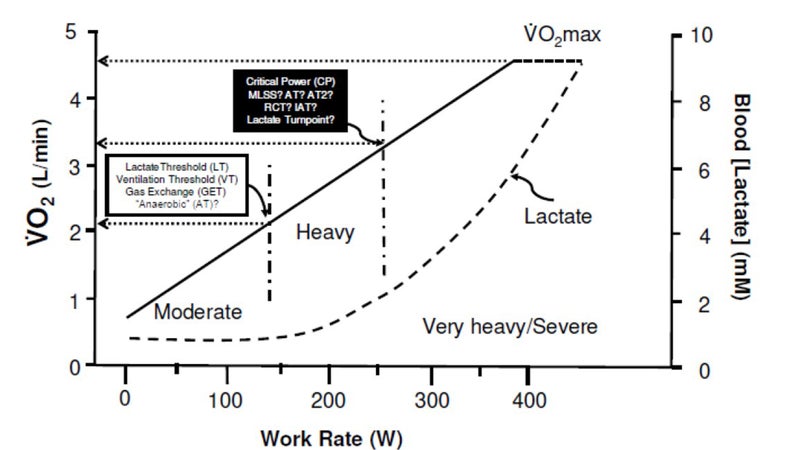Over the summer, a physiologist named Karlman Wasserman, formerly of UCLA, at the age of 93. The name may not ring a bell, but you can consider your next threshold workout an unofficial tribute to one of the giants of the field. He’s the guy who’s credited with coming up with the idea of the “anaerobic threshold” back in the 1960s—a concept that originally seemed straightforward, but that in the half-century since has turned out to be endlessly controversial and confusing.
As it happens, the Journal of Physiology recently published a massive new overview of this tangled history, called “,” by four of the most prominent researchers in the field, David Poole, Harry Rossiter, George Brooks, and Bruce Gladden. The main takeaway from the paper is that, contrary to the hand-waving explanations we’ve all heard, the anaerobic threshold does not represent the point at which you’re exercising so hard that your muscles can no longer get enough oxygen. What, if anything, it does represent is the topic of the other 73 pages of the paper. It’s heavy sledding, but here are a few of the highlights I took from it.
The Original Idea
Stripped down to its essence, the basic concept is that you can divide exercise into two distinct zones—call them “easy” and “hard.” That’s not a trivial or obvious statement. Exercise could easily exist on a continuum with infinite gradations of difficulty. But as early as 1930, researchers were talking about a “critical metabolic level” (known at that time as the Owles point). Below that point, you could exercise without accumulating any lactic acid in your blood; above that point, you’d see a steady rise in lactic acid, which at the time was believed to cause muscle fatigue. Anyone who has done lots of endurance exercise has an intuitive feel for that transition from sustainable to unsustainable.
Wasserman’s big insight was that you could identify that point by measuring breathing instead of taking cumbersome blood tests. His assumption was that the critical point marked the intensity at which the heart and lungs could no longer deliver enough oxygen to the muscles. The resulting oxygen shortage would force the muscles to rely on less efficient anaerobic energy sources, producing the dreaded lactic acid as a by-product and leading to a further cascade of chemical reactions that would produce extra carbon dioxide. As a result, if you carefully measured how much oxygen a subject breathed in and how much carbon dioxide they breathed out, a sudden change in the ratio would reveal that they had crossed what Wasserman dubbed the “anaerobic threshold.”
The Revised Idea
Wasserman’s ideas have been hugely influential, but our understanding of what’s really happening has changed. We don’t actually have lactic acid circulating in our blood; we have a related molecule called lactate. And lactate isn’t a dead-end waste product of anaerobic metabolism; it’s a hugely useful molecule that serves as an extra fuel source in the muscles and other parts of the body, and a signaling molecule that helps tell the body to adapt and get fitter. And, most importantly, lactate isn’t produced because your muscles can’t get enough oxygen.
The crucial difference between so-called aerobic and anaerobic energy systems isn’t that one uses oxygen and the other doesn’t. It’s that one is efficient but relatively slow, while the other is less efficient but can deliver lots of energy quickly. Once you start pushing hard, you simply can’t supply enough energy aerobically, so you have to start adding in some anaerobic energy—regardless of how much oxygen your muscles have. That means hard exercise will trigger an increase in lactate production. That’s what we would call the lactate threshold these days, and it corresponds to what Wasserman called the anaerobic threshold.
There’s one other twist. The levels of lactate you measure in your blood don’t just reflect how much lactate your muscles are producing. As noted above, lactate is also a valuable fuel, so you’re using up some of the lactate you generate. What you measure in the blood is the difference between lactate production and lactate reuse. One of the big adaptations that comes with endurance training is the ability to reuse large amounts of lactate—which means that even if you’re using some anaerobic energy and producing lactate, you can still settle into a sustainable metabolic state if you’re able to use the lactate as fast as you produce it.
The Two Thresholds
This new idea—elevated but stable levels of lactate—muddies the waters, because it means that there are really two different thresholds. The first is the intensity at which lactate begins increasing above its resting levels; if you exercise just above this threshold, you’ll have elevated but stable levels of lactate. The second is the intensity at which your lactate levels are no longer stable. Exercise above this intensity, and your lactate levels will increase steadily until you reach exhaustion.
Here’s a schematic from the Journal of Physiology article that shows lactate levels (dashed line) as a function of how hard you’re exercising (work rate, along the horizontal axis). It also shows the two thresholds, which divide exercise into three zones: moderate, heavy, and severe.

You’ll notice that the labeling of the thresholds is fairly confusing. By one count, there have been more than 25 different threshold definitions published in the literature using various criteria and nomenclatures. Following the lead of the review paper, I’ll call the lower threshold the lactate threshold.
The second threshold is trickier to pin down. It’s often called the lactate turnpoint (LTP) or maximal lactate steady-state (MLSS), because it’s the dividing line between metabolically sustainable and unsustainable exercise. But it’s hard to pin down on a lactate graph like the one above, the authors of the review point out, because it “represents an attempt to describe a curve with a single data point.” Instead, the most reliable way to identify this second threshold is to forget about lactate and use an alternate approach to identify your critical speed (or critical power, which is the same concept in different units).
I’ve written a few times before about critical speed, including this article that explains how to calculate it and how to use it to predict marathon time. In brief, if you take three all-out performances (races, for example) at different distances and plot them on a graph, you can calculate a theoretical speed at which you should be able to run forever. You can’t really go forever, of course—other sources of fatigue intervene. But that theoretical speed is your critical speed, and it marks the dividing line between what’s metabolically sustainable and unsustainable in terms of the mix of aerobic and anaerobic energy burned.
The Takeaway
Wasserman’s anaerobic threshold was the wrong name (it has nothing to do with lack of oxygen) for the wrong threshold (it’s critical speed, not lactate threshold, that marks the fundamental divide between sustainable and unsustainable). But it produced a lot of good science: the review authors quote Francis Bacon’s line that “truth emerges more readily from error than from confusion.”
And the lactate threshold, whether directly measured with finger pricks of blood or indirectly measured from the ratio of oxygen and carbon dioxide in the breath, is still a pretty useful concept. Critical speed can’t be measured directly without all-out exercise to exhaustion, which is inconvenient and sometimes impossible. Lactate threshold is more accessible, and still has plenty of predictive value for things like figuring out who is healthy enough to survive a major surgery.
In the running context, critical speed seems to be the better way of predicting marathon performance, as the recent data dump from Nike’s Breaking2 project suggested. But when I was reporting on Breaking2, the scientific team in charge was also interested in lactate threshold. The gap between lactate threshold and critical speed, they told me, gives you additional information about a runner’s strengths and weaknesses. Great marathoners have the two thresholds close together: they accumulate no lactate at all until they’re very close to their critical speed.
Middle-distance runners, on the other hand, tend to have a wide gap between thresholds: they start generating lactate at comparatively low intensities, but it doesn’t start shooting up out of control until a much higher intensity. Zersenay Tadese, the half-marathon world record holder at the time of the Breaking2 attempt, had a high critical speed but a , like a middle-distance runner. That may be one of the reasons he never managed to run a great marathon.
Personally, the threshold concept I still find most useful is the Talk Test. It also gives you three exercise zones: talking in full sentences; talking in short phrases; talking in single words, usually expletives. University of Wisconsin La Crosse physiologist Carl Foster and his colleagues have done a bunch of over the years showing how well the Talk Test lines up with more rigorous ways of determining thresholds. This isn’t surprising: the extra carbon dioxide associated with lactate accumulation is what makes you breathe more heavily, which interferes with your ability to speak. As for the details of what’s going on under the hood when you cross a threshold, the physiology may be a little more complicated than we used to think, but one thing hasn’t changed: if you’re an endurance athlete, you’d better be able to feel it.
For more Sweat Science, join me on and , sign up for the , and check out my book .


